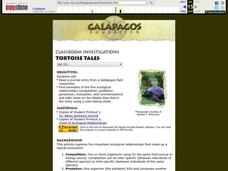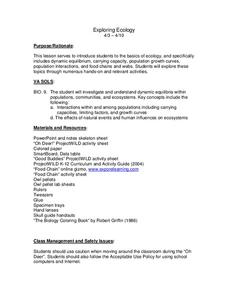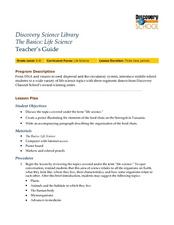Curated OER
Mimics Survive -- Camouflaged Reptiles
Students examine mimicry as a survival strategy in repiles. They examine examples of the Mexican milksnake and the coralsnake in attempt to distinguish the differences in them. They discuss other species that use mimicry.
Curated OER
Hide and Survive: A Natural Selection Activity
Students explore the theory of natural selection given certain scenarios. In this biology lesson, students graph data taken from the experiment. They explain the factors that contribute to the survival of the fittest.
Curated OER
Where Are the Dinosaurs?
Students view videos and websites and create finger puppets and hatchable eggs. In this dinosaur activity, students view video clips and a website to introduce the dinosaurs. They do a finger puppet play and create hatchable dinosaur eggs.
Curated OER
Insect Food Chain & Camouflage
Students use art work to demonstrate their understanding of the insect food chain and their ability to camouflage themselves. In this insect food chain and camouflage activity, students determine what type of animals feed on insects....
Curated OER
Interactions Among Living Things
Students role play predators and prey, classify organisms as predator or prey, and describe factors that affect population growth and size.
Curated OER
Paleoecology Using "Fossilized" Owl Pellets
Young scholars study the differences in anatomy to help identify different species and use a dichotomous key to identify what the owls were eating. In this investigative lesson students dissect owl pellets to identify the species...
Curated OER
Wildlife Animal Skulls
Students observe skulls of wild animals and determine their characteristics for survival. They evaluate the skuylls to discover the diets, and if the animals were predators or prey. They complete worksheets on mystery skulls.
Curated OER
It's all Interconnected
Students participate in a number of activities to investigate the food web, species extinction, predators and prey, and biological diversity.
Curated OER
Day and Night in the Desert
Pupils illustrate scenes showing day and nighttime activities in the desert. They include plant and animal life including predators and prey.
Curated OER
The Food Chain
In this food chain worksheet, students see 4 blank boxes over 2 blank lines. Each box is labeled with a new vocabulary word pertaining to the food chain. Students write a definition of each word and draw an example.
Curated OER
The Acetate Animal Hunt
Students determine which adaptations allow an organism to survive and reproduce in a certain environment. Students act as "predators" to pick up acetate discs "prey" scattered around the classroom. Students list the number found, the...
Curated OER
Life in the Kelp Forest
Students research and create a marine food web to learn about plants and animals in a kelp forest. For this marine food web lesson, students draw lines between kelp forest predators and prey and show the flow of energy in the food web....
Curated OER
Oh Panther
Students play a game that replicates the balance of prey and predators in an ecosystem. For this physical education lesson, students follow the instructions to play "Oh Panther!" Students collect data regarding the game and discuss the...
Curated OER
Tortoise Tales
Pupils read journal entry from a Gal??pagos field researcher, find examples of five ecological relationships (competition, predation, parasitism, mutualism, and commensalism) and take notes on the details they find in the entry using a...
Curated OER
Spiders are Special
First graders recognize that spiders are important natural predators. They work in small groups with simple field guides to identify as many of their spiders as they can.
Curated OER
Owl Pellets: A Fowl-Up, Chuck!
Students discover the world of owls as predators. After watching a video of owls hunting and eating, are introduced to owl pellets. Students dissect their own pellet and match the prey's bones to a bone diagram.
Curated OER
Escape! Survival of the Fittest Grasshopper
Fourth graders, in groups, design a paperclip grasshopper. They determine its ability to survive a prey by jumping high, far, or with a distracting behavior.
Curated OER
Exploring Ecology
Pupils explore the basics of ecology through numerous hands-on and relevant activities. They participate in an online food chain demonstration, which explores food web dynamics. They dissect owl pellets, examine the prey's bones, and...
Curated OER
Sharks and Fishes
Learners explain the role of the school of fish as the prey and the shark as the predator, as they participate in the game Sharks and Fishes. They demonstrate quick physical movement, and trickery, by sucessfully staying away from the...
Curated OER
Ambush Warriors
Students identify four different categories of reptiles and explain how snakes deliver their venom to their prey.
Curated OER
Lords of the Night
Second graders explore bird classification, specifically owls. They dissect their own owl pellet and explain the predetor and prey relationship.
Curated OER
The Basics:Life Science
Students explore concepts in life science using segments drawn from Discovery Channel. In this life science lesson, students participate in discussions about the food chain. Students create a poster to illustrate a predator and...
Curated OER
Mangrove Ecosystem
Eager ecologists explore ecosystems through video and photographs of a Mangrove. They discuss the animals in this habitat and how they interact with each other after reading and discussing "The Sea, the Storm and the Mangrove Tangle."...
Montana Natural History Center
Studying Grassland Ecosystems
At first glance, grassland ecosystems might seem dull and uninteresting, but once you start to explore it's amazing the things you'll find! Through this series of engaging lessons, activities, and experiments, elementary students examine...
Other popular searches
- Predator Prey Graph
- Predator Prey Relationships
- Predator Prey Game
- Predator Prey Parasite Host
- Predator Prey Population
- Predator and Prey Activities
- Predator Prey Cycles
- Predator and Prey Science
- Predator Prey Interactions
- Predator Prey Relationships
- Predator Prey Simulations
- Predator and Prey Balance























